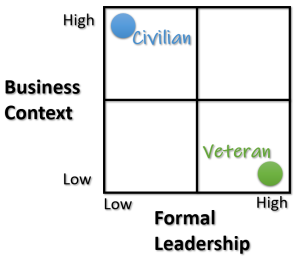
My Context:Leadership Grid.
It’s the grid you see depicted as this post’s image, and it’s one of the fundamental concepts I discuss when I address professional and industry audiences on the topic of Using First Principles Thinking to Solve Our Hiring Heroes Problem in the US (https://www.innovativepolicysolutions.org/articles/using-first-principles-thinking-to-solve-our-hiring-heroes-problem-in-the-united-states).
And for context, I specifically talk about the necessary union between civilian hiring manager and team mates and military veterans. Because it takes two to Tango. And all have a vein of shared experience, managing things, such as budgets, fleets of vehicles, equipment, and shops, and leading others to accomplish things the organization needs to accomplish, with limited resources and under deadlines and expectations.
And this one simple example illustrates what I call the “Charlie Brown Communication Problem”; we’re talking about the same things, but since we don’t understand the words used by the other party, each party only hears “Wha, wha, wha, wha, wha”, much like poor Charlie Brown sitting in class listening to his teacher drone on and on unintelligibly.
Civilians call their experience “management” experience because one of management’s four functions is Leadership, and veterans call their management experience “leadership”, because that’s what the military calls the person charged with planning what to do, how to get it done, when to get it done by, and with what resources and team members/units to use to get it done; gathering and organizing those resources and people; leading them in the execution of the plan from function one; and controlling performance by analyzing planned outcomes to performed outcomes and taking corrective actions to keep the two congruent.
The point of this post though, is that the civilian depth and breadth of knowledge about the tasks, the team, the organization, the industry, and the customers is vital to organizational success, and so is the ability to lead others, i.e., influence them, to perform, to purchase, to advocate, et cetera. This means that civilians are high on the Business Context axis because of their experience operating in civilian organizations while veterans were operating in the military to gain their experience.
Which makes veterans high on the Formal Leadership axis because they’ve been schooled in it, on-the-job trained in it, and promoted based upon their capability (capacity + ability) to do it.
This means that like a great Tango, for it to work, both partners have to contribute; constantly teaching the other what they know and can do while the other teaches them what they know and can do.
Cue the music Vets2PM; the traffic is piling into hiring dance hall’s parking lot!